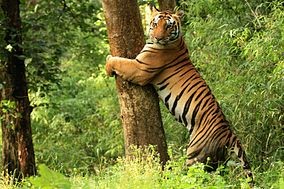There are these unique people who are fond of jungle safaris; they head off time and again to jungles – instead of the usual beaches, mountains, new cities and shopping. They have a penchant for those things related to wildlife. Through the safari they reconnect with nature. I call them naturalists. India is a home to wide variety of natural flora and fauna. It’s the home of one of the most majestic animals to walk on the face of this earth – the TIGER. But, the most depressing fact is that, we have failed to appreciate and value it.
Why Jungle safaris are beautiful?
The terrains in jungles are grand; they consist of grassland, small hills, bushes, water bodies, wild flowers, big sky-high trees and a wide variety of fauna. Mos t jungles have unknown plants and flowers. In every corner of the jungles you can hear the humming of wonderful birds and sounds of water flowing widely. The jungle has its own charm. Once you enter them, you are in the animal kingdom. The safaris take you on a wild ride which often is bumpy; from the open jeep you can watch variety of birds, animals, trees, flowers. Here, in the wild land, monkeys jump from branch to branch, milliards of insects bustle around, and some unknown animals move through the wilderness making a strange noise. The jungle has its own scent because of the wild yet scenic flora and fauna. Once you love the rugged terrain, the denseness of jungle I think nothing else is as beautiful as the jungle safari!!
t jungles have unknown plants and flowers. In every corner of the jungles you can hear the humming of wonderful birds and sounds of water flowing widely. The jungle has its own charm. Once you enter them, you are in the animal kingdom. The safaris take you on a wild ride which often is bumpy; from the open jeep you can watch variety of birds, animals, trees, flowers. Here, in the wild land, monkeys jump from branch to branch, milliards of insects bustle around, and some unknown animals move through the wilderness making a strange noise. The jungle has its own scent because of the wild yet scenic flora and fauna. Once you love the rugged terrain, the denseness of jungle I think nothing else is as beautiful as the jungle safari!!
Advisable in jungle safaris:
It is advisable to wear clothes which cover the arms and legs so that if you come in contact with insects or wild animals, you don’t catch an allergy. Wearing layers of clothing is also a good idea. Blend your Clothes with Nature. Stay Calm. Be composed and calm when inside the jungle. It is extremely important that you should stick to your group, headed by a naturalist. Travel light, only pack what you need inside the jungle. Do not forget to carry a good camera so that you can click some good photographs of the flora and fauna.
Other Necessary Items in Jungle Safaris
Raincoat, mosquito repellent, antiseptic creams, water bottle, band-aids, a small torch, first-aid kit, personal hygiene products and similar kind of items. Do not forget to carry sunhats, sunglasses and sunscreen to keep you safe from sun rays and sunburns. Wear covered comfortable shoes along with socks. Wearing exposed footwear might be a bad idea.
What not to do? Don’t Feed the Animals. Please do not litter. The jungle is home to the wild animals, thus, it is best that you do not litter your garbage here and there and dirty their home. Stay alert. If you see any visitor or staff doing any wrong, report it as soon as it is possible. Do not get too close to animals in order to observe them closely. Don’t talk loudly. No Loud Talks. The forest is not a place for long talks or conversation. It is wiser not to take small children or infants into the jungle as it is sometimes not possible to keep them calm. Please do not create any disturbance for the wild animals while taking videos or clicking photographs. Keep calm and turn off the flash on your camera. Stay away from using any flammable substances during your jungle safari. Last, but he least, it is advisable to keep your cell phones in your hotel room. If you are carrying them with you inside the jungle, keep them switched off or on silent mode.
Thanks to James Edward Corbett for starting a movement of saving wildlife in India. This Gentleman was a British-Indian hunter and tracker. He later turned conservationist. He wrote novels. ’Jim’ as he was fondly called, held a rank of colonel in the British Indian Army. He was often called by the then Government to kill the man-eating tigers and leopards in Garhwali and Kumaon regions which was then called United Province. Later on in his life, Jim Corbett became an avid photographer and spoke out for the need to protect India’s wildlife from extinction and played a key role in creating a national reserve for the endangered Bengal tiger, by using his influence to persuade the provincial government to establish what was called Hailey National Park. In 1957, the park was renamed Jim Corbett National Park in his honour.
Natural Conservation: We must for our own selfish interests allow the natural wild life survive. Understand the importance of it. The concepts of national park, wildlife sanctuary and wildlife conservation are no longer new in our country. Thanks to the electronic and social media which have been playing an important role in nature conservation. Many people misunderstand wildlife as tigers and lions; then there are those who think a national park is like a zoo or a public garden, or that it is surrounded by a high wall or a fence designed to control the movements of wild animals. People are under illusion that wild animals can survive on their own in these backwoods areas as indeed they have done since time immemorial, and therefore, such areas need no systematic, scientific management inputs. Only a few know that wildlife management is a specialized field with details of its own, and very few can appreciate even the basic hard work that goes into making a success of wildlife conservation in a national park or wildlife sanctuary.
We must make immediate efforts to educate little kids at the school level about importance of natural environment in terms of importance of jungles and wild life. They must be taught to appreciate the nature. Children must be taught about wildlife management; it is not a basic science, nor is it pure technology. It draws upon several disciplines including zoology, botany, ecology and even mathematics. It integrates a wide range of disciplines in logical, imaginative and pragmatic ways and, therefore, can be regarded as both a science and an art, whose practice is not very different from other professional courses such as medicine or law.
India is blessed with national parks such as Ranthambore National Park in Rajasthan, Hemis National Park in Ladakh on a high attitude, Jim Corbett in Uttarakhand, Bandhavgarh, Pench and Kanha in Madhya Pradesh, Gir in Gujrat, Kaziranga and Manas in Assam, Periyar in Kerala, Sunderban in West Bengal and Tadoba in Maharashtra.
The population of the tiger which was believed to be around 40,000 by some experts only a century ago was down to only 1,827 animals by 1972. The Asiatic lion, which adorns the country’s national emblem, is today confined to a small pocket in the Gir forests of Gujarat. A number of deer species like the Hangul of Kashmir, the Barasingha of Madhya Pradesh, the brow-antlered deer of Manipur, and antelope like the Himalayan – all adorn the list of endangered species.
In fact, the brow-antlered deer whose number in the wild was estimated to be only 18 in 1977 has the dubious distinction of being the most endangered deer in the world. Blackbuck, the graceful antelope of the Indian plains, was found in its thousands barely 50 years ago. It is now confined to small pockets where it survives only under strict protection. The Great Indian Bustard and the White-winged Wood Duck have dwindled to precarious numbers. The beautiful Siberian Crane is a winter visitor to the Bharatpur Sanctuary in Rajasthan. Its visit to this sanctuary dwindled to just 41 birds, as reported, in the winter of 1978-79. The Gangetic gharial, the marsh mugger and the estuarine crocodile have all been hunted down to near extinction. These are only a few examples; there are many more species of wild animals and birds that are on the verge of extinction.
If we are complacent towards conservation many of these beautiful creatures will be wiped out in the near future.















































